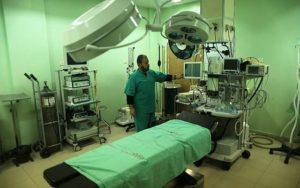COVID-19 threatens disaster in blockaded Gaza

Checks in the Beit Hanoun hospita, in the northern Gaza Strip after services stopped on 29 January 2018 when it ran out of fuel
Middle East Report Online publishes an interview with Salam Khashan, a physician at Nasser Hospital in Khan Yunis, Gaza, Palestine carried out on March 28, 2020, about the decimated Palestinian health care system and what this means for Gaza as COVID-19 looms, carried out by Danya Qato, an epidemiologist at the University of Maryland, Baltimore.
Q: Can you describe the barriers to public health and health care provision you experienced in Gaza before the emergence of COVID-19?
A: Before COVID-19, because of the economic blockade of Gaza by Israel, there were problems in all aspects of our life, including medical life. We don’t have enough hospitals, or primary care centers, we don’t have essential medications—about 50 percent of essential medications and supplies are not available—and even basic medical equipment like gloves, glucose test strips, pulsometers, and more, are not available in sufficient quantity.
The problem with the capacity of the medical system predates COVID-19 and was very stressful. We’ve always had a problem with the high number of patients. For example, recently I worked in a United Nations Relief and Works Agency (UNRWA) primary care clinic in Khan Yunis, and each day I had to see at least 100 patients in that shift (typically from 7:30 am to 1pm). That means I only have two minutes for each patient. That’s simply not enough time to do a comprehensive medical history and full physical exam.
In the Nasser Hospital Internal Medicine Department, one of the problems we’ve had to deal with is the lack of availability of medications. We may ask the pharmacy, for example, for ceftriaxone (an antibiotic) for patients with urinary tract infections and they tell us it’s not available and we have to choose an alternate medication. For patients with diabetes, we ask for glucose test strips to monitor their plasma sugar levels, and we’re told they aren’t available.
I also work in the government-run primary care centers, and some patients visit me more than four times, not because they have a new complaint but because they are checking to see if their medication is now available. Patients with chronic conditions like bronchial asthma, hypertension and diabetes mellitus have to have their medications on a daily basis and they don’t have the money to buy their own medications. The government can’t supply them because 50 percent of medications are not available, so I have to tell them to try again in another week or a few days.
